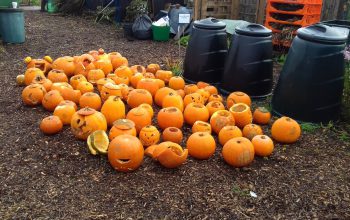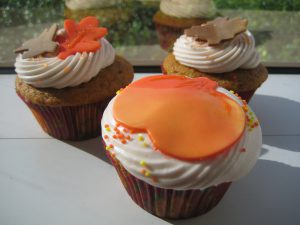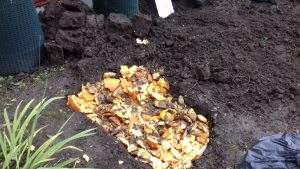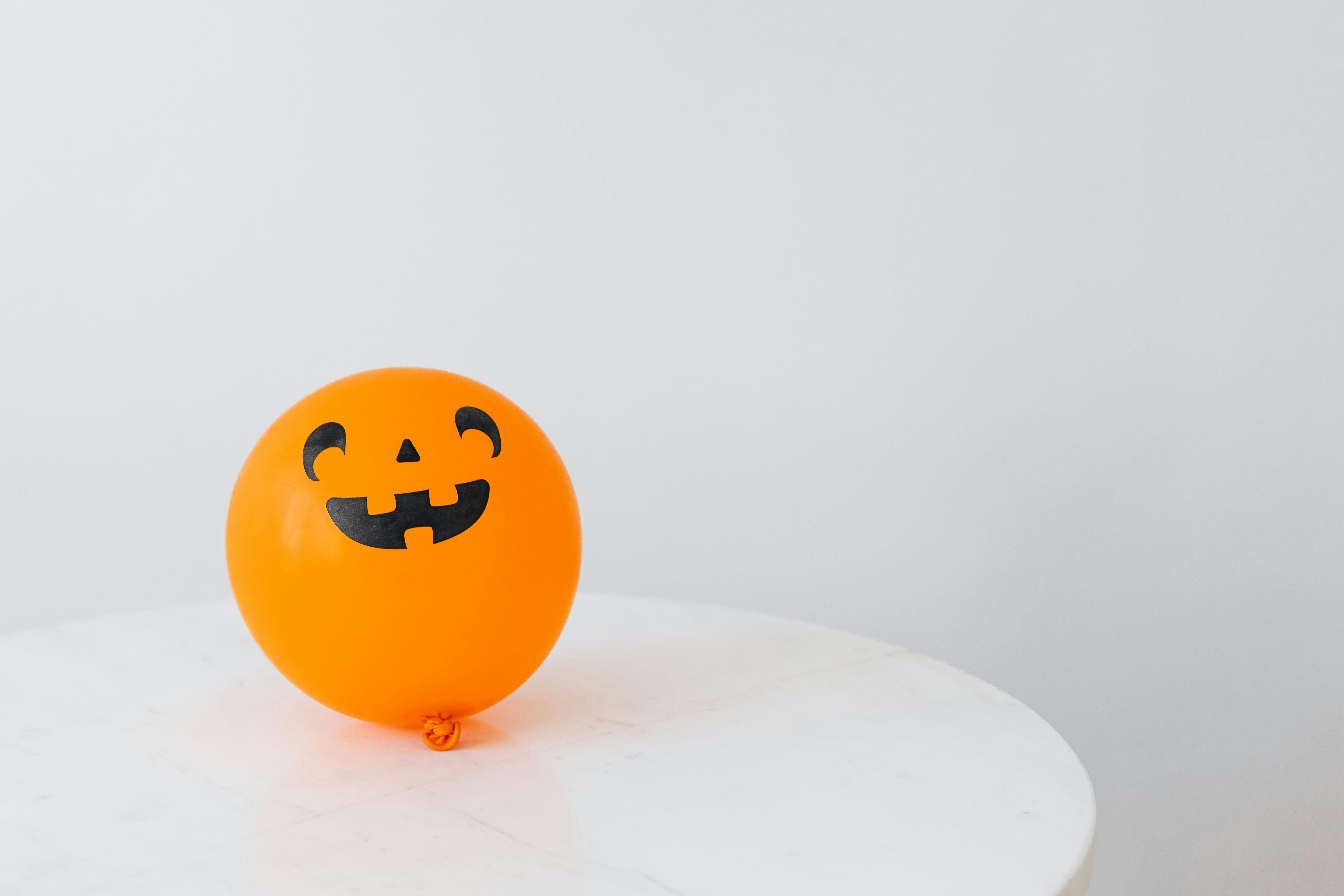Halloween waste
October 10, 2023

Halloween shouldn’t cost the earth
Halloween is quickly becoming one of the most wasteful celebrations of the year. We’ve put together some tips and advice to help you keep the financial and environmental cost of your Halloween to a minimum.
Read all the tips or just use the menu below to skip the section you’re most interested in, and don’t forget to check our Whats’ On page to find out about Halloween events and activities with a waste theme in Leicestershire.
Menu
- Plastic toys and decorations
- Batteries and WEEE (Waste Electronic and Electrical Equipment)
- Paper and card decorations & props
- Balloons
- Dealing with home made decorations and costumes
Top tips for a waste free Halloween
Make the most of your Pumpkins
Around 40 million pumpkins are bought each Halloween in the UK. Over half (nearly 22 million) will go uneaten (Hubbub – link opens a inforgraphic hosted on Facebook).
That’s a lot of unnecessary waste, especially considering that:;
- Pumpkins are food. Being a fruit they quite good for us and can be quite tasty. Their flesh contains no fat and is a great source of potassium and beta-carotene. It also contains minerals including calcium and magnesium, as well as vitamins E, C and B.
- Growing and transporting pumpkins has a carbon footprint, so if you are worried about climate change, it makes sense to eat your pumpkin. The amount of greenhouse gasses locked up in your pumpkin will depend on where it’s from and how it’s been grown. A study from 2011 found it to range from 139g to 448g of greenhouse gas per kilogram of pumpkin. The average pumpkin sold in a UK supermarket for carving weighs 6.8kg, so wasting one of these represents 1kg to 3kg of unnecessary greenhouse gas emissions. Times that by 22 million pumpkins and between 22,000 to 66,000 tonnes of CO2e gasses are being released into the atmosphere every single Halloween in the UK. All those emissions are for nothing if your pumpkin is used purely as a decoration.
If you want to have your Jack O’ Lantern and eat it, keep in mind that as a general rule, small pumpkins taste better than large ones – they’re less stringy and grainy and have thicker, less watery flesh. As they are smaller, you’ll have to spend less time separating out the flesh from the skin. If you choose a larger pumpkin, it’ll take longer to hollow out with minimal waste.
There’s no such thing as a ‘carving pumpkin’, they are all edible, it’s just that smaller pumpkins tend to have more flavour. Most retailers are now steering away from labelling their pumpkins as “for ornamental purposes only” but if you do spot one of these labels you can safely ignore it, presuming the pumpkin looks, feels, smells and tastes ok.
Remember that carved pumpkins don’t last long. They’ll begin to decompose within a couple of days of being cut, so delay carving into your pumpkin until as close to Halloween night as possible. Alternatively, you could paint it and add decorations instead. Keeping the pumpkin skin intact means it’ll keep fresher for longer, and when it’s time to eat it, you can simply wash off the paint and remove the decorations. All parts of pumpkins are edible, except for the tough stalks.
You’ll find a wealth of recipes and inspiration online, but Hubbub and Love Food Hate Waste (link opens Love Food Hate Waste Recipe search) both have good selections covering everything from pumpkin soup to kimchi and even pumpkin ale. If Pumpkin really isn’t to your taste, you might be able to bake some pumpkin based treats to hand out to trick-or-treaters. There are a selection of recipes that might be suitable below:

Pumpkin cupcakes use up pumpkin flesh from your Jack-O-Lantern and can be handed out to trick-or-treaters.
Whatever you decide to cook, it’s a good idea to choose a recipe (or two) before you go shopping. Aim to buy in any ingredients you’ll need at the same time as picking up your pumpkin, so make use of a shopping list. This means you’re more likely to actually cook and eat any of the flesh you save – rather than letting it fester in the fridge while you decide what you’re going to do with it.
If you do have to store the flesh for cooking later, put it into airtight containers (or a bowl covered with a wax wrap or clingfilm) and get it into the fridge within 2hrs of carving. You’ll then have around three days to make use of it, and make sure to retain the seeds, either for sowing and growing next year, feeding to the birds, or for roasting and eating yourself.
If you do intend to start your own pumpkin patch, it’s worth noting that pumpkin seeds can be sown from April to June, so dry your seeds and keep them in storage in a cool, dry, dark place over winter. Pumpkins require a huge amount of water and soil nutrients and so if you are planning on growing your own next year then having a supply of home compost and a water butt is a good idea.
If you really don’t fancy cooking your pumpkin, you might consider using it to make a range of beauty treatments instead. A pumpkin face mask might make for a good makeshift alternative to face paint and will leave you looking well moisturised.
It’s also worth remembering that other fruit and vegetables can be carved or decorated too. These can be presented raw (it turns out turnips are quite creepy) or served as a cooked dish.

A traditional carved turnip Jack O’ lantern preserved at the Museum of Country life, Castlebar Co Mayo, as a reminder that other vegetables can be spooky too.
If you do end up with some pumpkin waste, please dispose of the remains responsibly. A home compost bin is the ideal place to do it.
If you can’t compost at home, but do own some outdoor space then it’s worth considering that many garden birds, insects and other wildlife will appreciate feeding on a pumpkin, but put it somewhere high where hedgehogs can’t reach it. Also, Please only leave pumpkins out for wildlife in your own garden. Dumping your pumpkin at a local park, nature reserve, wood or other ‘wild place’ is fly-tipping, and as well as being illegal could risk causing harm to wildlife.
Once your pumpkin starts to rot and go mouldy it’s no longer appetising to most wildlife. at that point your pumpkin can be smashed up and composted. Alternatively, collect the pieces and bury them in a patch of soil in your garden (cover the pieces in a shallow grave with soil to a depth of 15-25 cm) where it will decompose completely over time and add nutrients to your soil.
If this isn’t an option, then you can put the pumpkin waste in your general waste bin. Please note that pumpkins, like other foods, shouldn’t be put in your garden waste collection bin.
Thrifty Costumes
If you want to dress up, the most sustainable option is to make a costume from things you already own or which you can borrow. You’ll find lots of ideas for inspiration and ‘how to’ guides online. If you do, make something, please keep your creations and use them again next year or pass them on to someone who will.
Make use of second hand market, swapping and sharing apps to rehome unwanted costumes and clothing, or to find one if you don’t fancy making your own:
If you have inherited a second hand costume, or found that your favourite from last year doesn’t quite fit any more, remember that they can always be altered and tweaked where required. There are numerous websites and Youtube channels containing a wealth of advice, tips and guides on repairing and making alterations to a wide variety of clothing and fabrics. If you’d prefer to learn in person check the Leicestershire Adult Learning Service website for details of upcoming fabric reuse classes and sewing courses.
If you don’t already have everything you need for your outfit, then check out your local charity shop.
If you’re short on time, or prefer to keep things simple, just raid your wardrobe to wear a Halloween colour-themed outfit instead.
Games and activities that don’t cost the earth
Keeping the family, and yourself, entertained with Halloween activities needn’t cost a lot of money or produce a lot of waste. Here are a few ideas:
- Make own toffee apples which can be decorated as you chose.
- Have a game of Snap Apple – tie string around apples (one for each person playing) and hang them from a tree branch, washing line, or similar. Ensure that the apple ends up at mouth height or slightly lower for each player. The idea is to eat the whole apple without touching it with your hands. You could give a prize to the person that manages to take a bite of theirs first. It’s not as easy as it sounds, and you could exchange the apple for a doughnut if that sounds more appealing.
- Have a go at bobbing for apples – float apples in a large basin filled with water. The idea is to grab one of the apples and remove it from the water using only your mouth. Hands are kept behind players’ backs. Please eat the apples afterwards to keep food waste to a minimum.
- Watch a scary film together as a family.
- Prepare your own indoor Halloween treasure hunt, either in the garden, or indoors if you don’t fancy venturing outside.
- Decorate your house with your own homemade recyclable decorations, there’s plenty of inspiration on the internet. Or alternatively invest in decorations that will last for years to come.
- Have fun making your own Halloween mask from cardboard. You could turn it into a competition with a prize for the best mask.
- Dim the lights, put on some spooky music in the background and take it in turns to tell a ghost story?

Apple bobbing is thought to date back to Roman times so really is a classic game.
If you are planning a Halloween party, please do:
- Make use of reusable plates and cutlery
- Look after your decorations so you can store them for use next year
- Portion appropriately. Don’t buy or serve more food than is likely to be eaten
- Collect recyclable and non-recyclable party waste separately
Sweet treats
If you anticipate being visited by trick-or-treaters this year, you’ll need something to give them. It’s tempting to buy small individually wrapped chocolates or sweets for this purpose. However, all those individual wrappers are a nightmare when it comes to recycling.
Believe it or not, a lot of sweets and chocolates go to waste after Halloween as many parents encourage their children to dispose of any leftovers in early November. Here are a few ideas for getting around these issues:
- Offer a non-food alternative to sweets; home–made seed bombs or small packets of wildflower seeds for example.
- Distribute healthier, packaging free alternative to sweets e.g. fruit
- Bake some treats yourself and offer them unpackaged – but choose a recipe carefully as anything you distribute is likely to be unceremoniously dropped into trick-or-treat bags and buckets along with everything else. You might also want to consider the 5-8% of children in the UK with food allergies, for whom trick or treating can be a genuine nightmare. The Teal Pumpkin Project has some advice for offering safe and inclusive treats for everyone.
- If you do buy pre-packaged sweets opt for those with minimal or easily recyclable packaging, and only buy as much as you can give away or are prepared to eat yourself.
- If you are left with more treats than you can eat, it’s better to share them than to let them go to waste. If friends and neighbours can’t accept your extras, it’s worth offering them to a wider audience using Olio or similar swapping / gifting websites.
Face paints & Makeup removal
If you’ve got face paints that have dried up since the last time you used them, it might be possible to revive or “reactivate” them rather than throwing them away. You’ll find detailed advice at the Facebodyart blog
If you’ve run out of face paints, keep the waste to a minimum by making your own using items from the kitchen: How to make your own face paint.
If you do intend to buy face paints then keep in mind that they are non-recyclable, so invest in a quality set that can be kept and reused next year without letting them dry out.
When it’s time to wash face paints off, please avoid wet wipes which can’t be recycled. You could try making your own washable make-up remover pads, or use a flannel instead.
Should you find that you’ve stained your clothes / costume with face paints you might find the advice below helpful:
- Soap and water work well to remove most face paint stains, but for stubborn stains try dabbing the affected area with some shampoo. Rub the shampoo into the fabric before rinsing thoroughly with fresh clean water. Make-up removal wipes and / or micellar water can also work wonders.
- Fake blood stains can sometimes be lifted with shaving foam. Spray a small amount of shaving foam on the affected area and rub it in with a clean cloth. Leave the foam to work for a few minutes before rinsing thoroughly with clean water.
- Coloured hairspray stains can be really stubborn. A heavily diluted bleach solution applied to wet fabric can help, but check to see if the garment is colourfast by applying a small amount of diluted bleach to an inconspicuous area first.
Top tips for disposing of common Halloween items
Pumpkins / Jack O’Lanterns
As mentioned earlier, either dispose of your waste pumpkins by composting them at home in a compost bin, or by chopping chop them up and burying them in your garden (known as trench composting).

Pumpkins being trench composted. Image courtesy of carryoncomposting.com
You can also / instead leave the flesh out for wildlife to eat but keep it on a bird table / other location where hedgehogs can’t get to it. Pumpkin acts as a laxative to hedgehogs and eating too much can cause them to lose vital body fluids and weight at a time of year when they need to be gaining weight to survive the winter.
As a last resort dispose of the pumpkin in your general waste bin. Remember that pumpkins, like other foods, should never be put into your garden waste collection.
Costumes
Unless your council allows the use of a dedicated collection bag, textiles including clothing, footwear, handbags, belts, towels, blankets, duvets, and pillows should not be disposed of in your kerbside recycling. Costumes in good condition can be sold or given away (see here). Charity shops will typically accept all kinds of textiles even if they aren’t in good enough condition to be re-worn, but remember to mark the bag as rags (charities can get an income by selling rags).
It is advisable to check what donations the charity shop are accepting before arriving. Alternatively, use a textiles/clothes bank. You can find your nearest textiles/clothes bank here. Never leave clothes in front of a closed charity shop or in front of a clothes bank, this is fly-tipping and is a criminal offence.
Batteries and WEEE

Decorating a Halloween storage box can make for a fun family activity.
However you store your Halloween decorations and costumes, do remember to remove batteries from anything that’s likely to be in storage for extended periods of time. This will prevent corrosion and will help to prolong the life of the battery and the item itself. The batteries can be used elsewhere until they’re dead / need recharging.
Dead batteries need to be kept separate from the other waste materials otherwise they can cause fires, explode and or a range of environmental issues. Batteries and devices containing batteries should never be put into your recycling bin or your general waste bin. Instead recycle them at your nearest battery collection point.
Plastic toys and decorations

Many toys and decorations are not recyclable owing to the materials they are made from.
Plastic toys and decorations should be kept and reused whenever possible. If you don’t want them, someone else might, and they could be sold or given away rather than wasted. There are lots of options for doing that, including freecycle, freegle, ebay, and Olio along with your local charity shop.
Unfortunately, the majority of plastic decorations and toys are made from hard plastics, often mixed with other materials, which can’t be recycled via kerbside recycling collections in Leicestershire. If you have toys you want to dispose of, please use your general waste bin, not your recycling collection.
However, toys and decorations that contain batteries, or which can be charged up, or which plug into the mains electricity supply are a bit different. These items are classed as WEEE (Waste Electronic and Electrical Equipment). WEEE can be recycled at many locations around Leicestershire including Recycling and Household Waste Sites. WEEE should never be placed into a kerbside waste or recycling bin.
Paper and card decorations & props

An increasing number of Halloween decorations are made from a paper or card-like materials. Those made of tissue or crepe paper (e.g., paper lanterns) can’t be recycled in your kerbside collection; the paper fibres are too short so these materials can’t be recycled. Paper and cardboard items containing a mixture of materials cannot be recycled via kerbside collections, for example cardboard bunting which contains; cardboard triangles, string or ribbon, glue and staples. These items should be disposed of in your general waste bin unless you are prepared to spend time carefully separating out the recyclable and non-recyclable components yourself. Keep an eye open for metallised plastic film which looks like shiny paper or foil. This thin plastic material isn’t recyclable either. You’ll be able to identify it by doing a scrunch test. Paper will scrunch into a tight ball and remain scrunched. Metallised plastic will not remain scrunched in a tight ball but will open straight out again.
Bunting is made of a composite of different materials and shouldn’t be put in a recycling collection unless you are prepared to separate out the recyclable from the non-recyclable parts.
Balloons
Balloons of any sort aren’t recyclable as part of your kerbside collection and should be disposed of in the general waste bin.
Dealing with home-made decorations and costumes
Dealing with your home made creations when they have reached the end of their life deserves a bit of thought as it can be challenging, particularly if your creation consists of different materials glued, stuck or sewn together. If you are keen to recycle as much as you can, start by separating out the different types of materials and assessing the recyclability of each component individually. Items covered in paint, glue, sticky tape or glitter are not recyclable and should be disposed of in the general waste bin.
Leicestershire residents can check the list of what items are accepted in your kerbside recycling.











